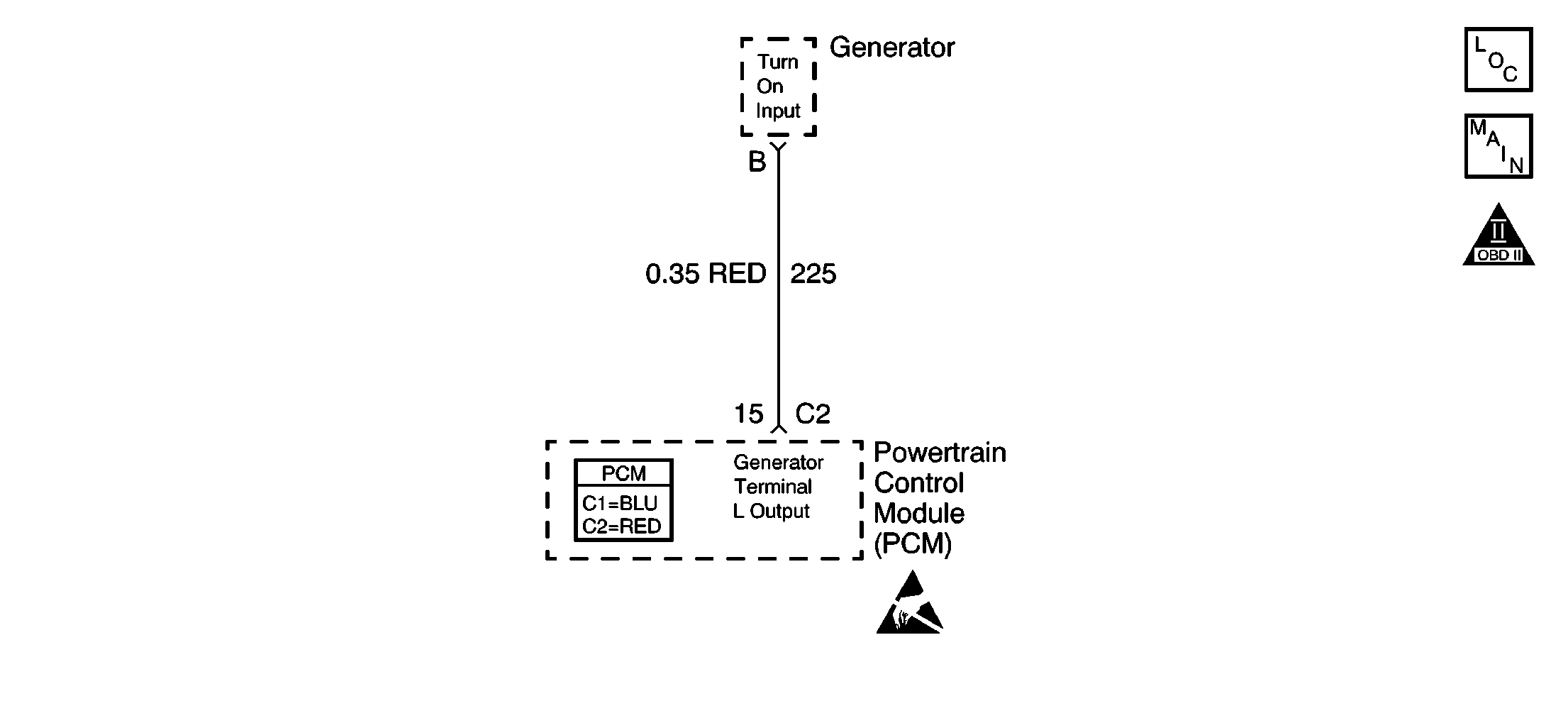
Circuit Description
The L-terminal circuit from the generator is a discrete circuit (a discrete circuit has no splices and only one source and one destination) into the PCM. The PCM applies ignition voltage to the generator L terminal circuit. A small amount of current flows from this circuit through the generator windings to create a magnetic field which starts the generator process. When the generator is at operating speed and producing voltage, a solid state switch for the L terminal circuit in the generator opens and the PCM detects that the initial startup current flow has stopped.
The PCM expects to detect low voltage on the L terminal circuit prior to the generator rotating at operating speed and conversely expects the circuit to be at ignition voltage potential when the generator is operational. When the PCM detects a fault (circuit shorted to ground, or circuit shorted to a voltage), this DTC will set.
Conditions for Running the DTC
Engine operating.
Conditions for Setting the DTC
The PCM detects an improper voltage on the generator L terminal circuit.
Action Taken When the DTC Sets
| • | The powertrain control module (PCM) stores the DTC information into memory when the diagnostic runs and fails. |
| • | The malfunction indicator lamp (MIL) will not illuminate. |
| • | The PCM records the operating conditions at the time the diagnostic fails. The PCM stores this information in the Failure Records. |
Conditions for Clearing the DTC
| • | A last test failed, or current DTC, clears when the diagnostic runs and does not fail. |
| • | A history DTC will clear after 40 consecutive warm-up cycles, if no failures are reported by this or any other non-emission related diagnostic. |
| • | Use a scan tool in order to clear the DTC. |
Diagnostic Aids
Important:
• Remove any debris from the PCM connector surfaces before servicing
the PCM. Inspect the PCM connector gaskets when diagnosing/replacing
the PCM. Ensure that the gaskets are installed correctly. The gaskets
prevent water intrusion into the PCM. • For any test that requires probing the PCM or component harness
connectors, use the J 35616
connector test adapter kit. Using this kit prevents damage to the
harness connector terminals. Refer to
Using Connector Test Adapters
in Wiring Systems.
A generator fault, such as a shorted output diode, malfunctioning regulator, open or shorted rotor, or open sense lead may cause a low battery charge. Refer to Diagnostic Starting Point - Engine Electrical in Engine Electrical for further information and generator diagnosis.
Use a scan tool in order to diagnosis the generator circuits. A scan tool displays Generator L-Terminal Inactive when there is a concern with the L-terminal circuit.
For an intermittent condition, refer to Symptoms .
Test Description
The numbers below refer to the step numbers on the Diagnostic Table.
Step | Action | Value(s) | Yes | No |
|---|---|---|---|---|
1 | Did you perform the Powertrain On-Board Diagnostic (OBD) System Check? | -- | ||
Does the scan tool display the Generator L terminal as Inactive? | -- | Go to Diagnostic Aids | ||
3 | Probe the Generator battery feed circuit using the J 35616-200 test lamp connected to ground. Refer to Probing Electrical Connectors in Wiring Systems. Does the test lamp illuminate? | -- | Go to Diagnostic Starting Point - Engine Electrical in Engine Electrical | |
4 |
Is the voltage the same or more than the value specified? | 10V | ||
5 |
Does the DMM indicate continuity? | -- | ||
6 | Test for continuity from terminal B at the generator harness connector to battery ground using the DMM. Refer to Testing for Continuity in Wiring Systems. Does the DMM indicate continuity? | -- | ||
7 | Repair the short to ground in the generator circuit. Refer to Wiring Repairs in Wiring Systems. Is the repair complete? | -- | -- | |
8 | Repair the open/high resistance in the generator circuit. Refer to Wiring Repairs in Wiring Systems. Is the repair complete? | -- | -- | |
9 |
Did you find and correct the condition? | -- | ||
10 |
Important:: Program the replacement PCM. Refer to Powertrain Control Module Replacement/Programming . Replace the PCM. Is the action complete? | -- | -- | |
11 |
Did you find and correct the condition? | -- | ||
Replace the generator. Refer to Generator Replacement in Engine Electrical. Is the action complete? | -- | -- | ||
13 |
Does the scan tool indicate that this test ran and passed? | -- | ||
14 | Select the Capture Info option and the Review Info option using the scan tool. Does the scan tool display any DTCs that you have not diagnosed? | -- | Go to the applicable DTC table | System OK |
